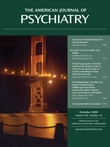Clinical Messages From the Treatment for Adolescents With Depression Study (TADS)
Abstract
TADS Should Matter to Depressed Adolescents Seen in Clinical Practice
Combined Treatment Significantly Accelerates Benefits
Treating Patients Longer Makes a Big Difference in Medical Benefit
Longer-Term Treatment Provides Sustained Benefit Once Treatment Is Discontinued
Adding CBT to Medication Minimizes Treatment-Emergent Suicidality
Combined Treatment is Cost-Effective in the Long Run
Other Contemporary Trials in Adolescent Depression
Summary and Public Health Implications
Footnotes
References
Information & Authors
Information
Published In
History
Authors
Metrics & Citations
Metrics
Citations
Export Citations
If you have the appropriate software installed, you can download article citation data to the citation manager of your choice. Simply select your manager software from the list below and click Download.
For more information or tips please see 'Downloading to a citation manager' in the Help menu.
View Options
View options
PDF/EPUB
View PDF/EPUBLogin options
Already a subscriber? Access your subscription through your login credentials or your institution for full access to this article.
Personal login Institutional Login Open Athens loginNot a subscriber?
PsychiatryOnline subscription options offer access to the DSM-5-TR® library, books, journals, CME, and patient resources. This all-in-one virtual library provides psychiatrists and mental health professionals with key resources for diagnosis, treatment, research, and professional development.
Need more help? PsychiatryOnline Customer Service may be reached by emailing [email protected] or by calling 800-368-5777 (in the U.S.) or 703-907-7322 (outside the U.S.).

